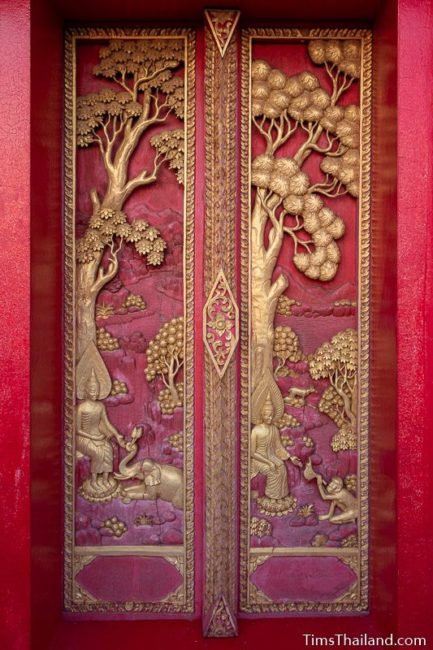อ่านภาษาไทยที่นี่ (Click here to read a Thai version.)
The carved wooden doors on the sixth floor of Phra Mahathat Kaen Nakhon stupa at Wat Nong Wang tell many of the main episodes from the Buddha’s life up to and including his enlightenment. The artist was Tawon Gonkaew.
The story begins at the northeast corner on the east wall (in front of the stairs) and is told counterclockwise around the stupa. The Buddha’s life story continues down below on floor 5.
If you want to read more about the Buddha’s life story, the two-volume The Splendour of Enlightenment: A Life of the Buddha by Phra Khantipalo, is a thorough (though not quite complete) version based entirely on texts from the Pali Canon. And for an account of the major events with scholarly commentary (in particular pointing out different, often contradictory, versions of various episodes found in the ancient texts), The Buddha: A Short Biography by John S. Strong is excellent.
— — —
While still in Tusita heaven, the Buddha-to-be prepared for his final birth (choosing when, where, and who) and gave a final sermon to the other gods. He chose King Suddhodana, the thoroughly righteous ruler of the Sakya clan, who was respected by everyone, and the wise and pure Queen Maha Maya to be his parents.
The queen had a dream where the gods took her to the Himalayas and a white elephant walked around her three times. When she awoke, sixty-four brahmins explained that the dream foretold the queen was pregnant with a son who would either become the ruler of the whole world or a Buddha.
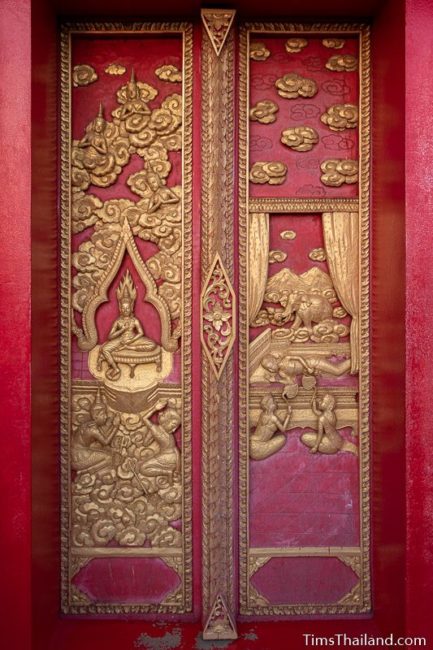
Queen Maha Maya was traveling to her father’s home on a full moon day when she went into labor. She gave birth in Lumbini Park, standing up and holding on to the branch of a sal tree.
Prince Siddhattha emerged from her womb pure and undefiled by any blood or bodily fluid. He immediately took seven steps, with a lotus flower arising under each, and proclaimed he was the Chief of the World and this was his last birth.
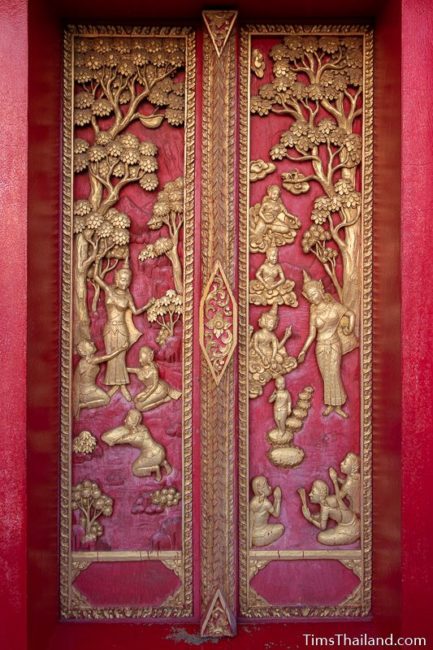
The Sage Asita heard the gods cheering and asked what made them so happy. Hearing the good news, he went to the royal palace in Kapilavatthu city where he bowed down at the prince’s feet and announced that this baby was a Buddha-to-be.
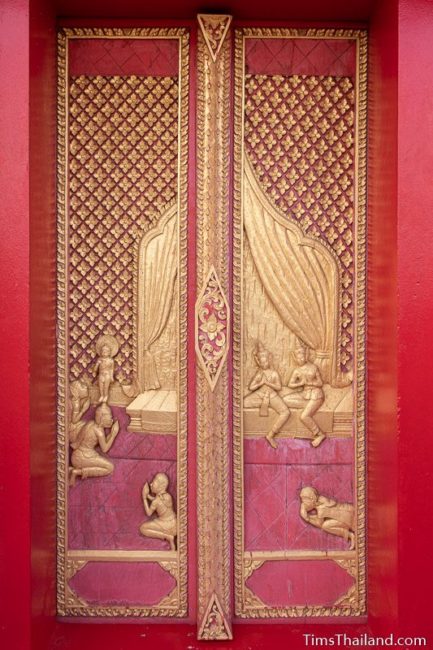
Years later, the king took his young son to a royal ploughing festival and placed him on a seat under a tree. While his nurses watched the festivities, the prince sat up and did his first meditation. As the day progressed, shadows moved with the sun as normal, except that the shadow of the prince’s tree remained motionless over him.
When Prince Siddhattha turned sixteen and was ready to wed, many Sakya elders did not believe he was suitably adept at the warrior arts because he lived such a pampered life in the palace. So to prove himself, he held a demonstration of his archer skill. He was the only one amongst all the princes who had the strength to bend his grandfather’s powerful bow.
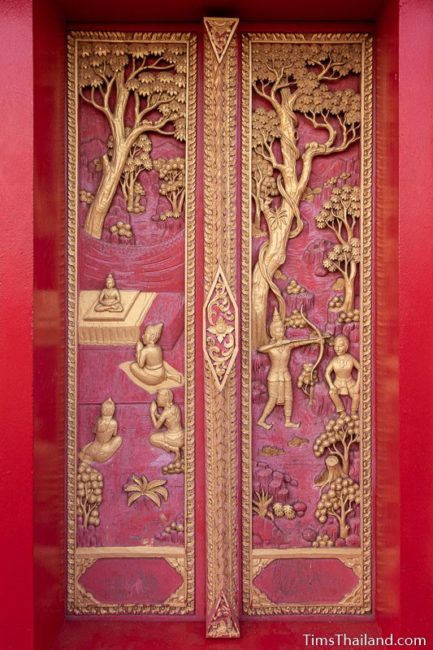
When Prince Siddhattha married the incomparable Princess Yasodhara, the god Brahma came to bless them by pouring water over their hands.
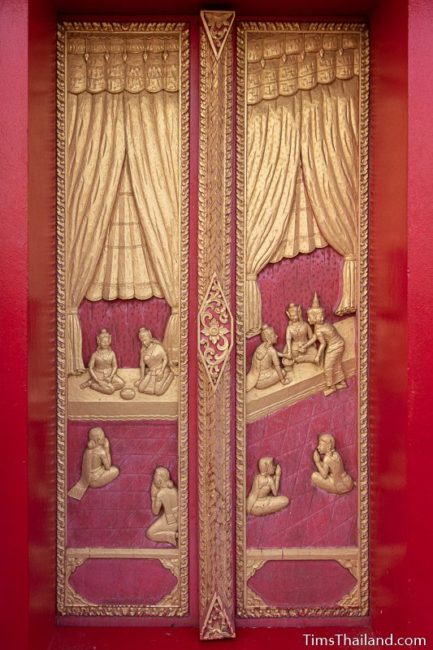
Prince Siddhattha lived an idyllic life with three palaces, thousands of dancing girls in his harem, and everything he wanted, but he was not happy. One day he decided to go see the beautiful gardens around his family compound. The king ordered everyone to clean and decorate the city and hide anything and anyone that wasn’t perfect. But the gods wanted to help the Buddha-to-be and as the prince rode through the streets, one took the form of a decrepit old man with wrinkled skin, a bald head, missing teeth, and a stooped body walking wobbly with a staff and struggling to breath. The shocked prince had never seen a person like this before and asked his servant and charioteer, Channa, what was wrong with the man. He answered that he was old, and explained that this was the fate of all humans eventually. The prince grew depressed and returned home.
Another day Prince Siddhattha chose to visit the park. The king ordered the route to the park cleaned up, but the gods did their magic again and the prince encountered a loathsome, jaundiced sick man with swollen hands, feet, and face and flies feeding on an open wound. Channa explained what disease was and that everyone was at risk of being robbed of beauty, strength, and joy by it. The depressed prince chose to return home rather than continue to the park.
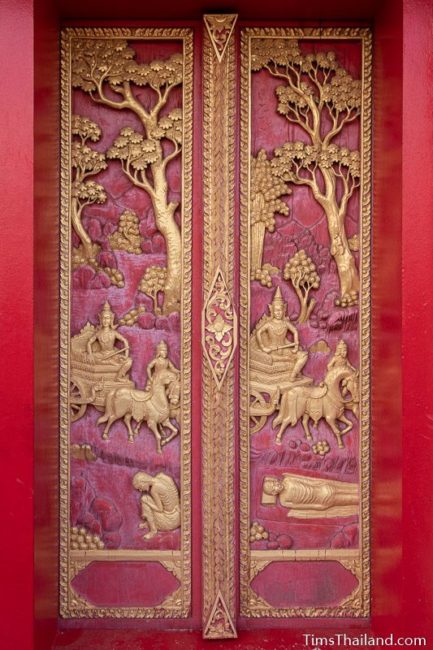
Later, Prince Siddhattha wanted to visit the forest. Again the path was beautified by order of the king, and again the gods intervened to thwart him; this time in the form of a corpse. The prince had never heard of death before and after Channa explained it, the prince ordered him to turn back to home.
Again the prince had the urge to visit the park, and again the king gave his orders. This time a god took the form of a graceful religious ascetic in yellow robes carrying an alms bowl. The prince stopped to talk to the ascetic who explained that he was a man of peace and simplicity and was searching for the path to salvation.
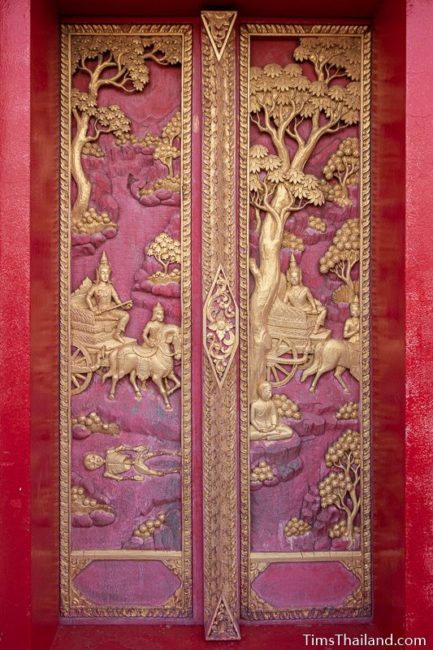
Having seen these four sights (which his father had been warned about) Prince Siddhattha thought about leaving home and seeking the end of suffering. That same day while he was out, Princess Yasodhara gave birth to their first child, a son he named Rahula (“Impediment”), and he returned home to great festivities. He was surrounded by woman as beautiful as heavenly nymphs dancing and singing and playing music to entertain him, but he had no interest and quickly fell asleep. Later in the dead of night he awoke and saw the women sleeping disheveled on the ground and to him they seemed not like angels, but like corpses, and he decided to leave right away. He took a look at his wife and son sleeping side by side, but said nothing to them so there was no chance of changing his mind.
Prince Siddhattha mounted his trusty horse Kanthaka and with the help of Channa, who held onto Kanthaka’s tail, began his Great Renunciation.
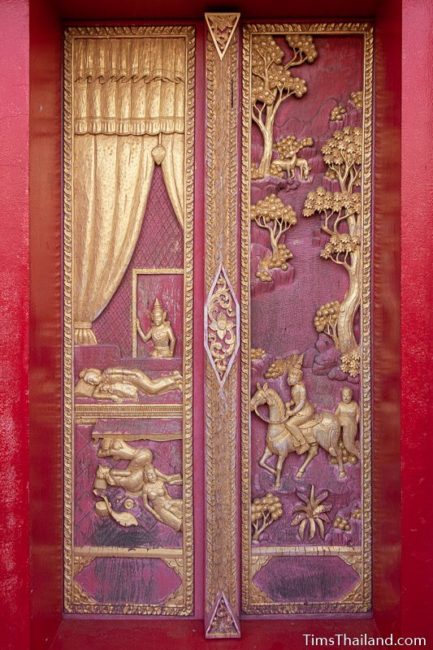
They left the city by flying over the city wall and rode far away to the Anomiya River where Prince Siddhattha cut his hair off with his sword.
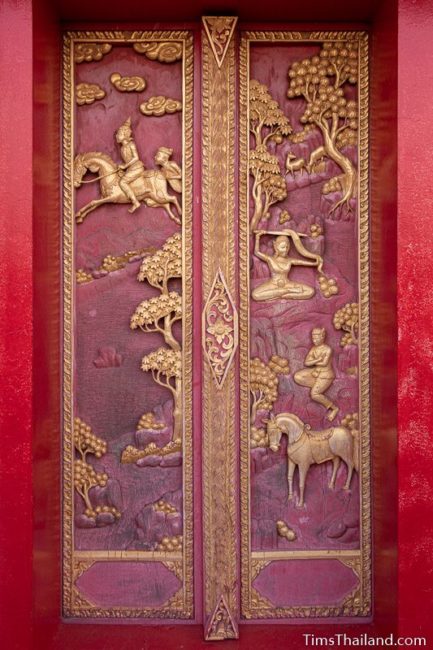
The gods collected the Buddha’s hair and took it to heaven for worship as a relic.
His silk clothes being inappropriate for his quest, a god brought the prince a rough saffron-colored robe.
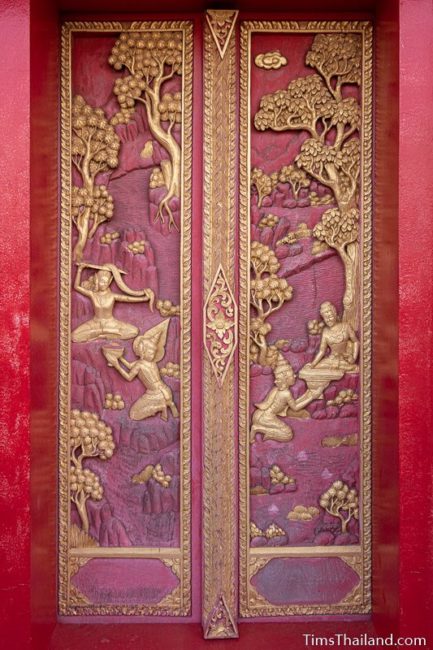
Prince Siddhattha sent Channa and Kanthaka back to the palace with a message for his family and the rest of the city that if he managed to reach enlightenment he would return. Kanthaka was so overcome with sorrow from the prince leaving that he died of a broken heart and was reborn in heaven.
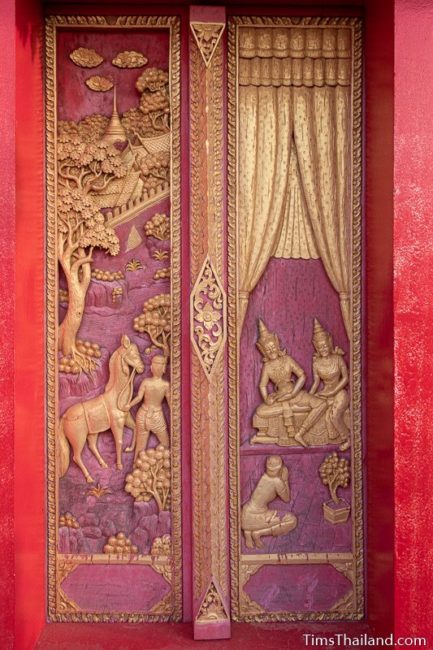
Now known as Samana Gotama, he lived along with five friends as an ascetic. Believing that suffering would let him reach supreme wisdom, he tortured himself in various ways – going days without food, sleeping on thorns, not bathing, holding his breath until his head hurt, and more. He grew sick and weak: his ribs stuck out and his skin shriveled up.
After six years of extreme austerity without gaining perfection, Samana Gotama realized it was not going to happen through extreme living. Indra, king of the gods, came down to earth in the form of a man to set him on the right path. He played his lute and the first string he plucked was so tight it broke, the next was so loose he could barely hear it, and the third was properly tuned and made a beautiful sound. And this is how Samana Gotama knew that he could only reach enlightenment by following the Middle Way. He ate solid food to restore his vigor and the group of five ascetics who lived with him left in disgust.
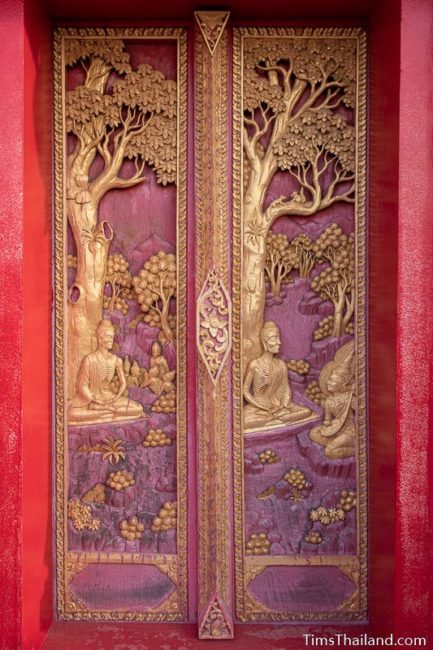
(These two door panels should be in the reverse order. The scene on the viewer’s right happens before that on the left.)
The next morning Samana Gotama went and sat under a tree. A maiden named Sujata had once asked the spirit of this tree for a husband of equal rank and a son, and her wish came true. On the day he came, Sujata had prepared special sweet milk porridge (she fed the milk of one thousand cows to five hundred cows, then their milk was fed to two hundred fifty and so on until eight cows gave the final most nourishing milk possible) for her annual offering to the spirit. And when she saw Samana Gotama there emanating a golden glow, she believed he was the tree spirit come in human form to receive her gift.
Sujata had served the porridge in a golden bowl worth one hundred thousand coins. After eating, Samana Gotama took the bowl to the river and said, “If I shall succeed in becoming a Buddha today, let this bowl go upstream.” The bowl floated upstream to the middle of the river and sank, landing atop the bowls of the three previous Buddhas of this aeon who had long ago been here and done the same.
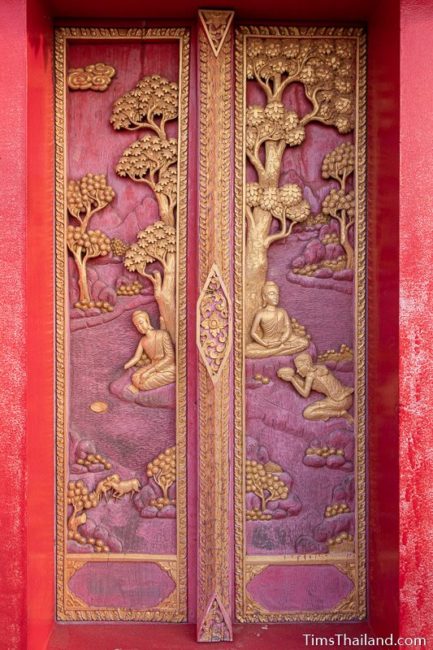
That same evening, Samana Gotama took a seat under a tree (later called the Bodhi Tree) and vowed to not leave until he reached enlightenment. Mara, “The Evil One,” did not want him to succeed so he attempted to break his purpose with desire, sloth, honor, boredom, etc. – which is always illustrated in temple as an army attacking him. But Samana Gotama successfully resisted these sensations – which is usually shown as touching the ground to call the Earth goddess, Mae Thorani, to come be his witness that he had accumulated enough merit to be ready for enlightenment: she squeezes water (this was all the water poured over the Buddha-to-be’s hands in gratitude for all the good deeds he had done in his many previous lives) from her hair to flood the army away.
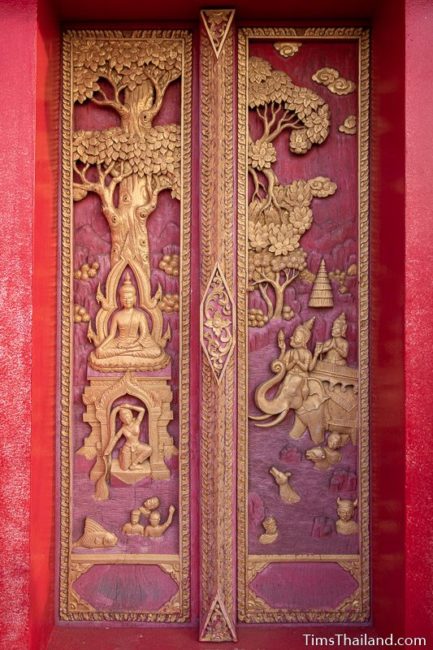
With his purified mind, free from defilements, he meditated through the night and by dawn he had remembered his hundreds of thousands of previous births, truly understood the impermanence of all things and the law of karma, and discovered the four noble truths and the eight-fold path. He had reached perfect enlightenment and was no longer subject to the cycle of rebirth or the misery of desire. He now knew how to end suffering. He was a Buddha.
For the next seven weeks, the Buddha remained near the Bodhi tree to meditate. The first week was under the same Bodhi tree and he delighted in the bliss of emancipation. Then he moved to a new place each week.
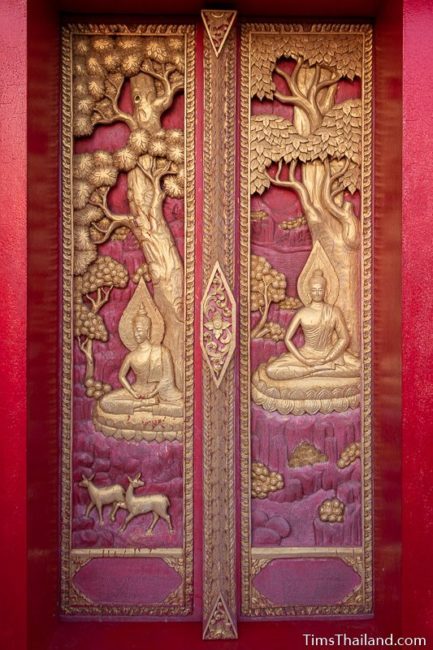
(Chronologically this final scene happens much later in the Buddha’s life and should be on floor 5 alongside the story of Cinca-Manavika. Apparently the workers installed it here by mistake.)
When a monk unintentionally broke a monastic rule by leaving some waste water in the bathroom, another monk had him put on probation. This led to a large quarrel between two groups of monks, one experts in dharma and the other experts in the vinaya rules for monks. The Buddha told both factions they were at fault and three times he told them to restore harmony in the brotherhood, but they did not. Unable to settle their conflict, the Buddha left the commotion behind and went to stay in the forest for a rainy season. During his three months there, he was cared for by an elephant and a monkey who brought him food and water.
